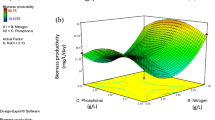Abstract
The high cost of algal cultivation has been a barrier associated with the commercialisation of algal biodiesel. Therefore, this study aimed to enhance lipid production by optimising the nutrient supply to benefit the coexistence of Dunaliella salina and Nannochloropsis gaditana. The effects on biomass and lipid production of using different proportions of D. salina and N. gaditana, urea and NaHCO3 were optimised by response surface method with a 17-run Box–Behnken design. The optimal conditions for the algal growth are 58 % of D. salina in the mixture at OD680, 150 μL day−1 urea (0.0044 g day−1) and no addition of NaHCO3. The biomass concentration and lipid production reached 1.00 and 0.383 g L−1, respectively, which are exceeded by the amount before optimisation, indicating the efficiency of the model obtained by response surface method.



Similar content being viewed by others
References
Assaf T, Beyschlag W, Isselstein J (2011) The relationship between plant diversity and productivity in natural and in managed grasslands. Appl Ecol Env Res 9:157–166
Berman T, Bronk DA (2003) Dissolved organic nitrogen: a dynamic participant in aquatic ecosystems. Aquatic Microb Ecol 31:279–305
Bligh EG, Dyer WJ (1959) A rapid method of total lipid extraction and purification. Can J Biochem Physiol 37:911–917
Bracken MES, Stachowicz JJ (2006) Seaweed diversity enhances nitrogen uptake via complementary use of nitrate and ammonium. Ecology 87:2397–2403
Cardinale BJ (2011) Biodiversity improves water quality through niche partitioning. Nature 472:86–89
Danesi EDG, Rangel-Yagui CO, Sato S, Carvalho JCM (2011) Growth and content of Spirulina platensis biomass chlorophyll cultivated at different values of light intensity and temperature using different nitrogen sources. Braz J Microbiol 42:362–373
DOE US (2010) National algal biofuels technology roadmap. US Department of Energy Office of Energy and Renewable Energy, Biomass Program
Gamfeldt L, Hillebrand H (2011) Effects of total resources, resource ratios, and species richness on algal productivity and evenness at both metacommunity and local scales. PLoS One 6(7):e21972. doi:10.1371/journal.pone.0021972
Goldman J, Oswald WJ, Jenkins D (1974) The kinetics of inorganic carbon limited algal growth. Water Pollut Contr Fed 46:554–574
Griffiths M, Harrison S (2009) Lipid productivity as a key characteristic for choosing algal species for biodiesel production. J Appl Phycol 21:493–507
Guillard R (ed) (1975) Culture of phytoplankton for feeding marine invertebrates. Culture of marine invertebrate animals. Plenum, New York
Guillard RRL, Ryther JH (1962) Studies of marine planktonic diatoms. I. Cyclotella nana Hustedt and Detonula confervacea Cleve. Can J Microbiol 8:229–239
Hillebrand H, Lehmpfuhl V (2011) Resource stoichiometry and consumers control the biodiversity–productivity relationship in pelagic metacommunities. Amer Nat 178:171–181
Hsieh CH, Wu WT (2009) Cultivation of microalgae for oil production with a cultivation strategy of urea limitation. Bioresour Tech 100:3921–3926
Inouye BD (1999) Integrating nested spatial scales: implications for the coexistence of competitors on a patchy resource. J Animal Ecol 68:150–162
Inouye BD (2001) Response surface experimental designs for investigating interspecific competition. Ecology 82:2696–2706
Jiang L, Luo S, Fan X, Yang Z, Guo R (2011) Biomass and lipid production of marine microalgae using municipal wastewater and high concentration of CO2. Appl Energy 88:3336–3341
Liu J, Mukherjee J, Hawkes JJ, Wilkinson SJ (2013) Optimization of lipid production for algal biodiesel in nitrogen stressed cells of Dunaliella salina using FTIR analysis. J Chem Technol Biotechnol. doi:10.1002/jctb.4027
Mallick N, Mandal S, Singh AK, Bishai M, Dash A (2012) Green microalga Chlorella vulgaris as a potential feedstock for biodiesel. J Chem Technol Biotechnol 87:137–145.
Masyuk NP, Posudin YI, Lilitskaya GG (2005) Photomovement of algae: a comparative taxonomic aspect. Int J Algae 7:310–333
Rocha JMS, Garcia JEC, Henriques MHF (2003) Growth aspects of the marine microalga Nannochloropsis gaditana. Biomolec Eng 20:237–242
Russell G, Fielding AH (1974) The competitive properties of marine algae in culture. J Ecol 62:689–698
Savage N (2011) Algae: the scum solution. Nature 474:S15–S16
Solomon C, Collier JL, Berg GM, Glibert PM (2010) Role of urea in microbial metabolism in aquatic systems: a biochemical and molecular review. Aquat Microb Ecol 59:67–88
Spijkerman E, Wacker A (2011) Interactions between P-limitation and different C conditions on the fatty acid composition of an extremophile microalga. Extremophiles 15:597–609
Stockenreiter M, Graber AK, Haupt F, Stibor H (2012) The effect of species diversity on lipid production by micro-algal communities. J Appl Phycol 24:45–54
Weis JJ, Madrigal DS, Cardinale BJ (2008) Effects of algal diversity on the production of biomass in homogeneous and heterogeneous nutrient environments: a microcosm experiment. PLoS One 3(7):e2825. doi:10.1371/journal.pone.0002825
Williams PJB, Laurens LML (2010) Microalgae as biodiesel & biomass feedstocks: review & analysis of the biochemistry, energetics & economics. Energ Env Sci 3:554–590
Acknowledgments
The author would like to thank the China Scholarship Council for supporting this research financially, and also Dr. Jim Gilmour, Dr. Chen and Professor Catherine Biggs for laboratory assistance.
Author information
Authors and Affiliations
Corresponding author
Rights and permissions
About this article
Cite this article
Liu, J. Optimisation of biomass and lipid production by adjusting the interspecific competition mode of Dunaliella salina and Nannochloropsis gaditana in mixed culture. J Appl Phycol 26, 163–171 (2014). https://doi.org/10.1007/s10811-013-0099-z
Received:
Revised:
Accepted:
Published:
Issue Date:
DOI: https://doi.org/10.1007/s10811-013-0099-z




